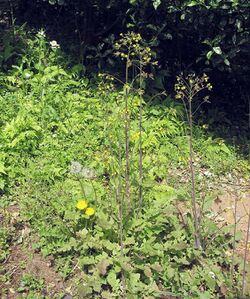Biology:Youngia
From HandWiki
Short description: Genus of flowering plants
| Youngia | |
|---|---|

| |
| Youngia japonica | |
| Scientific classification | |
| Kingdom: | Plantae |
| Clade: | Tracheophytes |
| Clade: | Angiosperms |
| Clade: | Eudicots |
| Clade: | Asterids |
| Order: | Asterales |
| Family: | Asteraceae |
| Subfamily: | Cichorioideae |
| Tribe: | Cichorieae |
| Subtribe: | Crepidinae |
| Genus: | Youngia Cass. |
| Type species | |
| Youngia lyrata | |
| Synonyms[3] | |
| |
Youngia is a genus of Asian plants in the tribe Cichorieae within the family Asteraceae. There are several weedy species in the genus as well as the endangered Youngia nilgiriensis from Sispara in southern India , and Youngia japonica, which is also known as Japanese hawkweed.[4]
Youngia was first described in 1831 by H. Cassini,[5] and the genus was later united with Crepis.[6] Taxonomic and cytogenetic studies by E. B. Babcock and G. Ledyard Stebbins led to the reclassification of the genus in the 1930s.[7][8][9]
- Species[3]
References
- ↑ lectotype designated by Nelson, C. H. 2008. Catálogo de las Plantas Vasculares de Honduras 1–1576. Secretaria de Recursos Naturales y Ambiente, Tegucigalpa
- ↑ Tropicos, Youngia Cass.
- ↑ 3.0 3.1 Flann, C (ed) 2009+ Global Compositae Checklist search for Youngia
- ↑ Flora of China Vol. 20-21 Page 252 黄鹌菜属 huang an cai shu Youngia Cassini
- ↑ Cassini, Alexandre Henri Gabriel de. 1831. Annales des Sciences Naturelles (Paris) 23: 88-90 descriptions and commentary in French
- ↑ Bentham & Hooker, Genera Plantarum 2 (1873): 514
- ↑ Babcock, E.B. and Stebbins, G.L. 1937. The genus Youngia. Carnegie Institution of Washington
- ↑ Everitt, J.H.; Lonard, R.L.; Little, C.R. (2007). Weeds in South Texas and Northern Mexico. Lubbock: Texas Tech University Press. ISBN:0-89672-614-2
- ↑ Koh Nakamura et al., 2012. Extreme habitats that emerged in the Pleistocene triggered divergence of weedy Youngia (Asteraceae) in Taiwan. Molecular Phylogenetics and Evolution 63: 486–499.
Wikidata ☰ Q1071397 entry
 |

